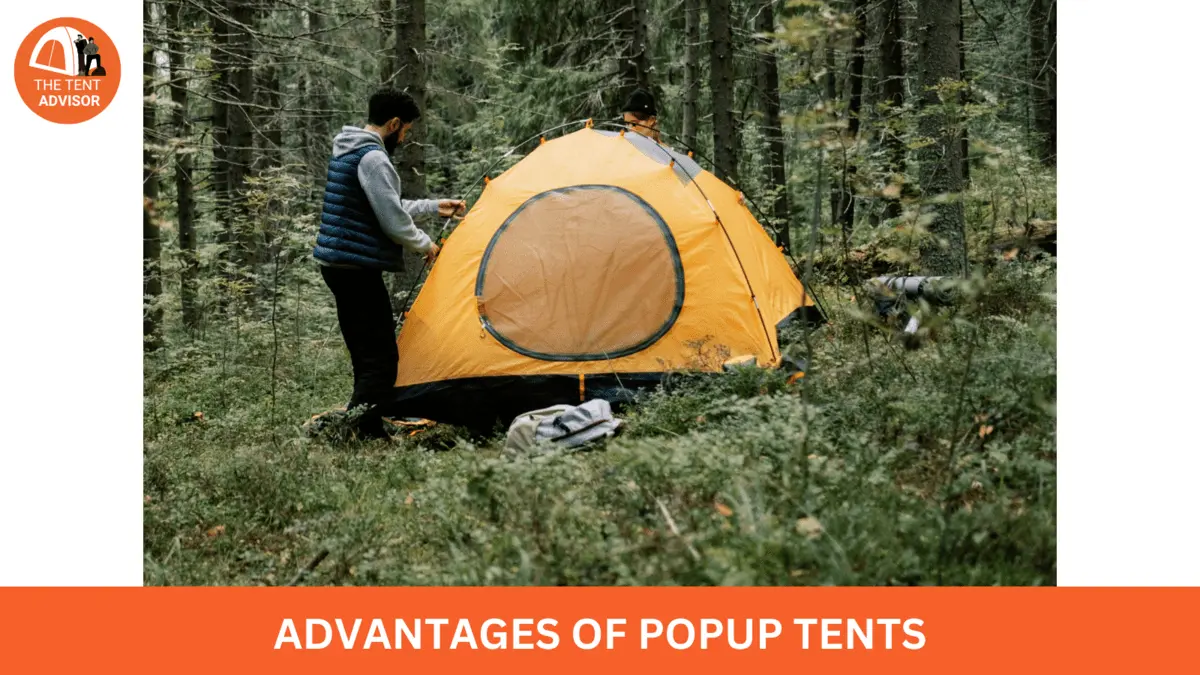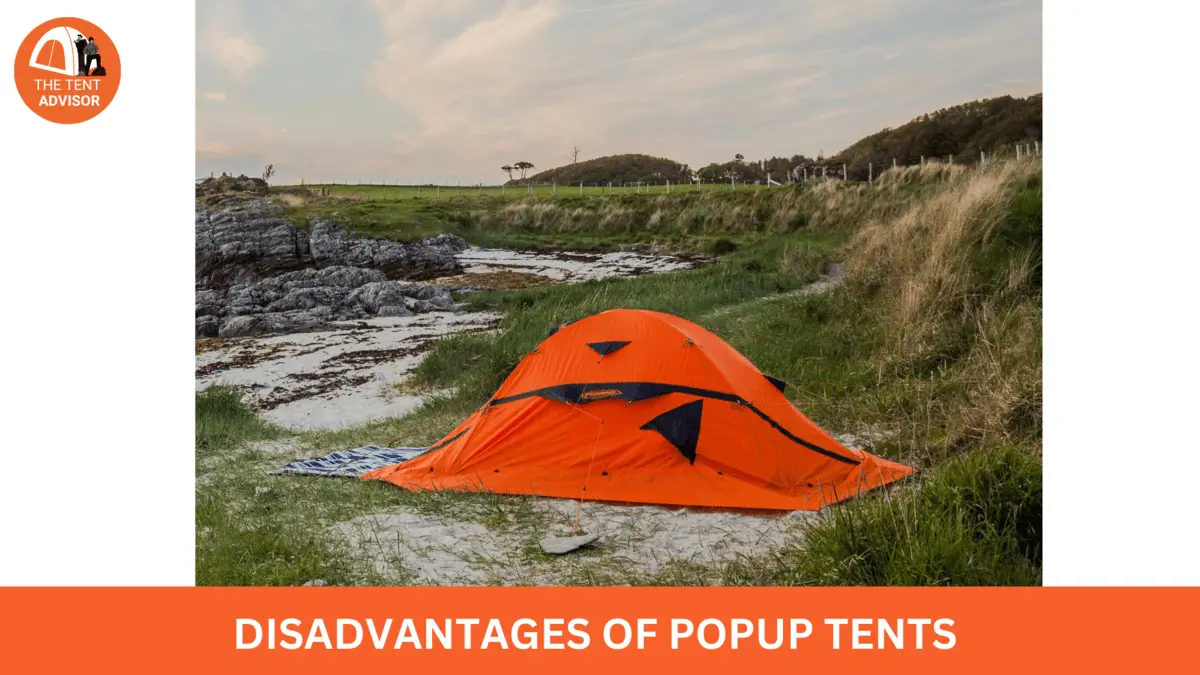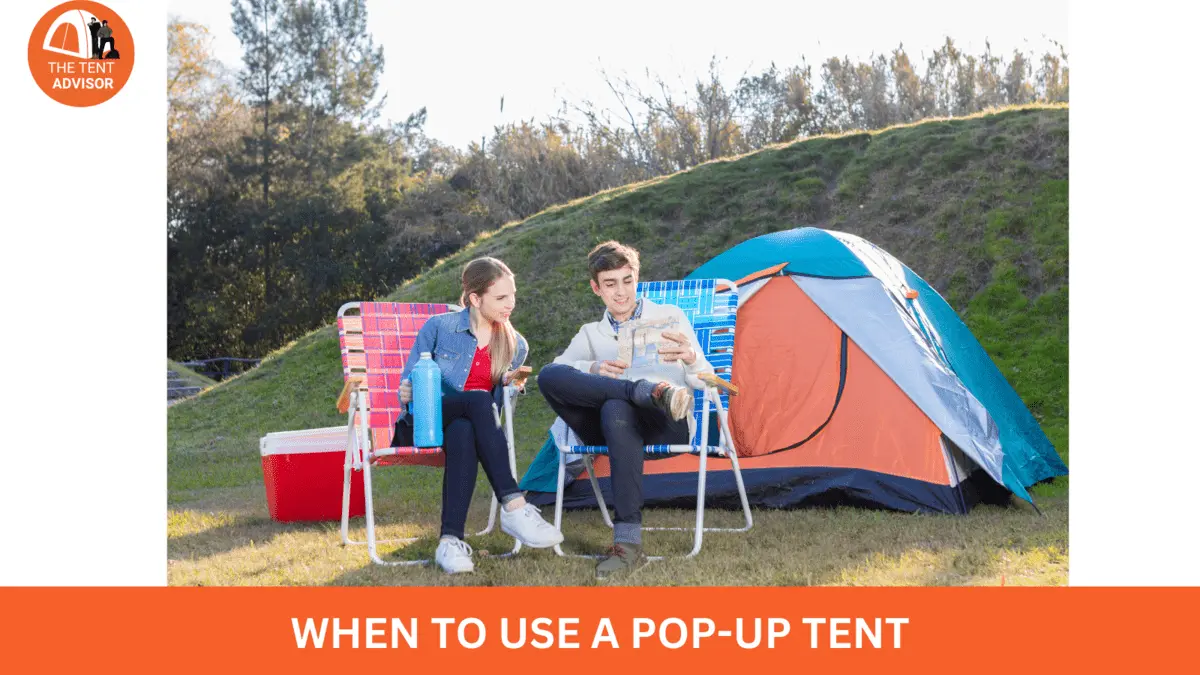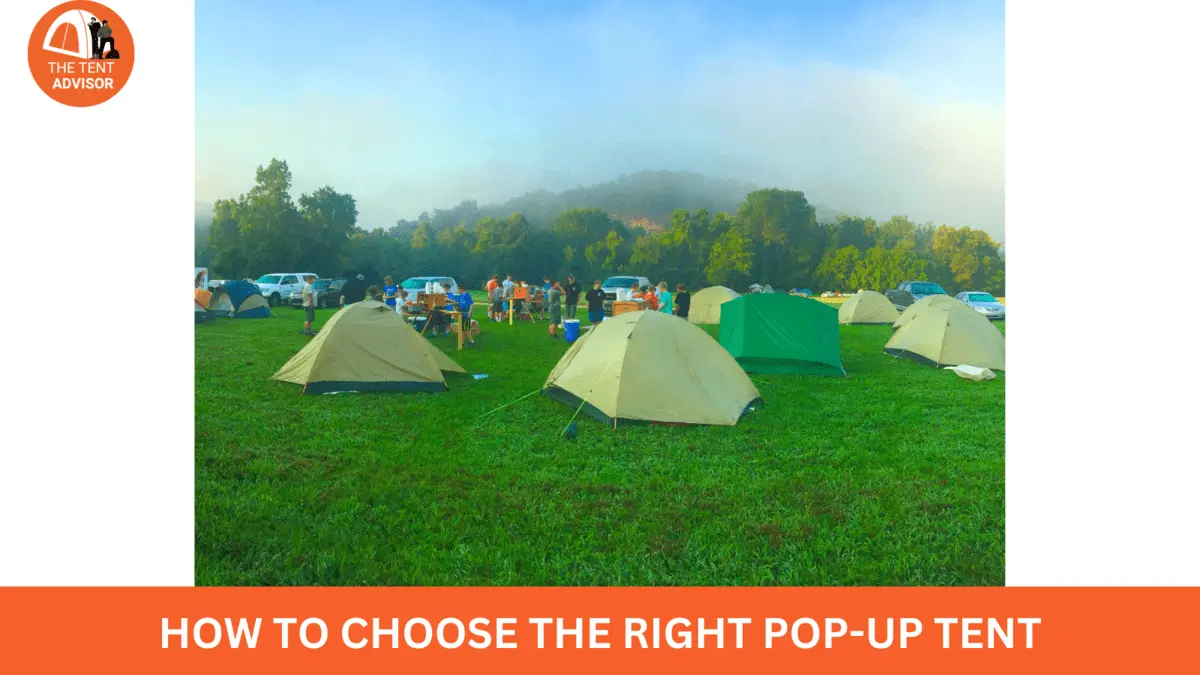Over the years, there has been an increase in the demand for pop-up tents mainly because they are relatively cheap and easy to use. They have been around for some time, but their opinions are divided.
Some camping lovers highly recommend such tents as ideal for weekend getaways. In contrast, others argue that they are not genuine tents.
We will discuss in detail: Are Pop Up Tents Good? What are their advantages and disadvantages? Keep reading.
Are Pop-Up Tents Good? Advantages and disadvantages
Below, we will discuss the details on Are Pop Up Tents Good? when to use an alternative and what to look for in a popup tent.

Quick Setup
One of the main drawcards of pop-up tents is their swift setup. Imagine getting to your campsite in less than two minutes after work on Friday evening and having your tent ready. Modernizing how fast pitching occurs helps reduce barriers to accessing camping, making outdoor adventure more regular.
Affordable
Additionally, they are pocket-friendly. Large retailers like Amazon, Argos, and Go Outdoors offer various budget pop-up tent options, This makes them appealing choices for those who want to go camping without spending much money.
Lightweight
The days when you had heft-heavy tents around you are long gone; modern-day pop-up tents are designed for easy carrying since they are lightweight. Unlike the old-fashioned unwieldy ones that needed several people to move them about, these can be carried by hand or put in bags, hence preferred by contemporary campers.
Versatility
In addition, one can also use a pop-up tent for occasions such as festivals, beach tours, weekend camping escapades, or backyard adventures, among others. Its cost-effectiveness and short setup periods make it popular, especially during summer.
When you need to go to a festival or simply live out in your yard, pick a pop-up tent and enjoy convenience plus flexibility that cannot be found anywhere else.
Convenience
The easy setup process enables pop-up tents to be installed in just a few minutes. This is quite an attraction for non-enthusiastic camping folks who would rather not struggle with the traditional tent assemblies after a long work week.
Quick Setup:
Pop-up tents are incredibly easy to set up. They usually unfold and spring into shape within seconds, making them convenient and fast.
Fast Take Down
They also pack away quickly, which can be a big plus if you’re on the go or prefer an easy experience.
Lightweight and Compact:
Many pop-up tents are designed to be lightweight and compact when packed, making them easy to transport.
User-Friendly:
Pop-up tents are simple to assemble and dismantle; therefore, these are recommended for beginners who find complicated tent designs challenging.
Disadvantages Of Popup tents
Although popup tents have many advantages they contain downsides too .

Poor Durability
In most cases, though, Durability is not one of their strengths compared with regular types. They are often made from cheaper materials compared with conventional tents. In contrast, they do not last long due to poor seams, zippers and poles. Although some high-quality options might be available at a higher price, it undermines the benefit of affordability.
Questionable Water Resistance
The majority of pop-up tents lack water resistance features. Most of them have hydrostatic head (HH) ratings between 1000 – 1500, which may serve well during slight drizzles but weakly protect against heavy continuous downpours. Furthermore, weak stitches usually lead to leaking through permeating inside the tent.
Lack of Air Circulation
Pop-up tents also do not have enough air circulation. This can result in moisture collecting inside the tent and condensing on internal walls by morning. Keeping the interior dry and comfortable is more challenging due to poor airflow.
Sustainability
The accessibility of pop-up tents has resulted in their mass production and disposal, especially at festivals. These tents are mostly abandoned after a single use, contributing to environmental waste. This is because they are usually made from non-eco friendly materials and shipped from China, thus increasing their carbon footprint.
Weakness
The materials used for making pop-up tents generally lack the strength of regular tents. Usually, seams, zippers, or poles are of low quality, making them wear out faster. While the cost might be low initially, multiple costs of replacing such items may prove expensive over time.
Environment Impact:
These objects are easily discarded, causing environmental pollution, particularly if left on festival grounds after use.
Protection from Wind:
Pop-up tents typically don’t have very good wind resistance compared to dome styles. These designs generally cannot withstand strong gusts well or contain extra guy lines that one can use for support during rough weather conditions.
Rain Protection:
On the other hand, many pop-up models perform poorly during heavy rains mainly because they lack a rain fly or have limited waterproofing abilities, exposing you to water seepage during storms.
Materials:
More often than not, materials used in making pop-up tents tend to be thinner and less lasting than those employed in traditional buildups. This shorter life expectancy could manifest through frequent use or harsh terrains, especially in this form of camping gear.
Difficult Repairs:
Repairs may be more difficult with damaged pop-up tents because of the spring-loaded poles and internal construction.
Airflow Problems:
While some pop-up tents have limited choices in terms of ventilation. Inside such a tent, lack of enough fresh air movement might result in condensation and stuffiness.
Indoor Space:
Pop-up models may provide less interior space and headroom than some designs of the same size. Thus, they might also contribute to lower comfort levels, affecting taller individuals or those needing more space.
When To Use A Pop-Up Tent

Car Camping:
You only hike for short distances and drive right up to your camping spot. This makes assembly and disassembly easier.
Short Trips:
These are excellent options for minor camping expeditions in mild weather conditions.
Leisure Use:
They are great for easy taking out on weekend holidays or music festivals but lack the rainproofing measures required in traditional tents.
When To Look For Alternatives
Backpacking:
In these cases, bulky packing sizes and heavier weights make them incompatible with pop-up tents, for example, during long-distance walking tours.
Extreme Weather Conditions:
If you expect severe weather conditions (heavy rain, strong winds etc.), you should consider getting a regular dome tent or a high-quality one designed for harsher climates.
Long-Term Camping:
For longer trips or more challenging situations, investing in something more durable with increased resistance from weather elements might be necessary.
Pop-up tents suit some camping situations, especially where convenience and portability are essential. However, when considering camping trips to more demanding environments or for longer durations, you may need a more robust and weather-proof tent.
Who Needs a Pop-Up Tent?

Pop-up tents are very flexible and helpful for different users and scenarios. Sellers at open-air markets or fairs find them particularly handy because they give a moveable, easy-to-use shelter for selling their wares while improving the appearance of their stalls and protecting them from exposure to outdoor elements.
Another group that uses pop-up tents is event organizers, who set them up in various outdoor locations during weddings, parties, or corporate get-togethers. Some of these can serve as dining rooms, lounges, or reception points, which makes guests feel more comfortable.
Who May Need a Large Pop-Up Tent
Those in need of bigger shelters should consider large pop-up tents. These tents will come in handy for events like weddings, corporate functions, or music festivals that require accommodating many indoor visitors who would otherwise be exposed to weather variability.
When used by companies participating in trade shows and other promotional events, bigger sizes make it possible for client interaction, thus leading to higher sales volumes. The same structures also serve as command centres during emergencies like natural disasters, where affected persons can take refuge.
Businesses frequently use pop-up tents to promote their brand at trade shows, sports events and other marketing activities.
They’re able to draw attention if customized with logos and branding materials. In response to emergencies, these are provided by emergency teams to offer temporary relief when natural calamities have hit the area, among others, creating a haven where both the responders and victims are protected.
How to Choose the Right Pop-Up Tent

Several factors should be considered when choosing the right pop-up tent. Start by determining the size requirements, which depend on how many people will occupy it and the space available within your chosen venue or camping site.
Evaluate its Durability and resistance to harsh climatic conditions by examining strong frames (aluminum/fibreglass) along with water-resistant UV protective fabric material, which is also of high quality. When it comes to outdoor tents, more robust zippers and reinforced seams are ways to improve their Durability.
Portability is another factor, especially if one wants something they can easily take with them; therefore, it means selecting a lightweight option that folds up into a small size and comes with an easy-to-carry bag. Clients also need to know the optional extras that they may consider adding on from side walls for privacy or branding should it be necessary.
Finally, budget versus value can help you find the best tent suitable for your needs. By considering these aspects carefully, you will choose a pop-up tent as an effective solution for those who love being outdoors.
Are Popup tents Good or Bad: The Verdict
Pop-up tents are practical and cost-effective options for simple campers who desire ease while camping, mainly in perfect weather conditions. Nevertheless, repeated campers who think about longevity, better protection against the elements, and long-term use may find investing in sturdier tents more worthwhile. Also worth noting is the environmental impact of these products, given that many people dispose of them when they are no longer needed.
Pop-up tents make sense for some camping purposes, but it depends on what kind of outing you plan and where you’ll stay. Here’s what they can offer and some things they don’t:
FAQ: Are Pop-Up Tents Good
Are pop-up tents good in the rain?
Pop-up tents can be used in the rain, but their effectiveness largely depends on the tent’s construction and features. Here’s what to consider:
Waterproofing: Not all pop-up tents are designed with solid waterproofing. Many are splash-proof or water-resistant but may not withstand heavy rainfall for extended periods.
Rainfly and Seams: Check if the tent includes a rainfly, a separate layer of waterproof fabric covering the tent. Also, inspect the seams to seal them properly to prevent water from seeping through.
Maintenance: If your pop-up tent is not very waterproof, consider applying a waterproof spray or sealant to enhance its resistance to rain.
Can you sleep in a pop-up tent?
Yes, you can sleep in a pop-up tent. They are designed for various uses, including camping and outdoor trips. Pop-up tents are generally comfortable for sleeping, but the comfort level can vary based on the tent’s size, design, and the quality of its materials. Some pop-up tents also double as play tents for children or additional event space.
Do pop-up tents have AC?
No, pop-up tents typically do not come with built-in air conditioning. They are more essential than modern campers and are designed for quick setup and convenience rather than luxury features. For cooling, you might use portable fans or choose a well-ventilated location for the tent.
How waterproof is a pop-up tent?
The waterproofness of a pop-up tent varies by model and manufacturer. Generally:
Water-Resistant: Most pop-up tents are water-resistant rather than fully waterproof. They can handle light rain but may only be reliable during heavy downpours with additional waterproofing measures.
Waterproof Ratings: Check the tent’s specifications for waterproof ratings. Tents with higher ratings are better equipped to handle wet conditions. Look for features like a high-quality rainfly and sealed seams.
Is It Worth Buying a Pop-Up Tent?
The answer to whether a person should buy this type usually depends on how frequently he goes camping and what his needs are while out there. The advantages, like quick setup time and affordability, are notable, but so are the disadvantages.
Related information:
